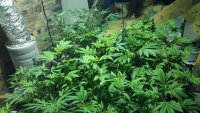mojuan
Well-Known Member
just had a conversation with the kid kinda went like this.
hay dad, it would be easier if we went hydro, you already have the flood trays and reservoir, they just fill up then drain back into the reservoir, me: oh yea, it would be easier to water, BUT!
i know there are going to be hydro vs soil people on here and i don't want to start a long drawn out discussion, I'm trying to do a pro's and con's list I've only been growing since november so i dont know nuttin. he just bought me a book and I've only read 1 book in my life.
how about a automatic watering system for soil instead of full blown hydro no soil. i know there is more options, like a hybrid watering setup in soil? just asking

hay dad, it would be easier if we went hydro, you already have the flood trays and reservoir, they just fill up then drain back into the reservoir, me: oh yea, it would be easier to water, BUT!
i know there are going to be hydro vs soil people on here and i don't want to start a long drawn out discussion, I'm trying to do a pro's and con's list I've only been growing since november so i dont know nuttin. he just bought me a book and I've only read 1 book in my life.
how about a automatic watering system for soil instead of full blown hydro no soil. i know there is more options, like a hybrid watering setup in soil? just asking




 .
.
 .
.

 . People here generally love to help, and that goes doubly for helping others learn to grow cannabis.
. People here generally love to help, and that goes doubly for helping others learn to grow cannabis.